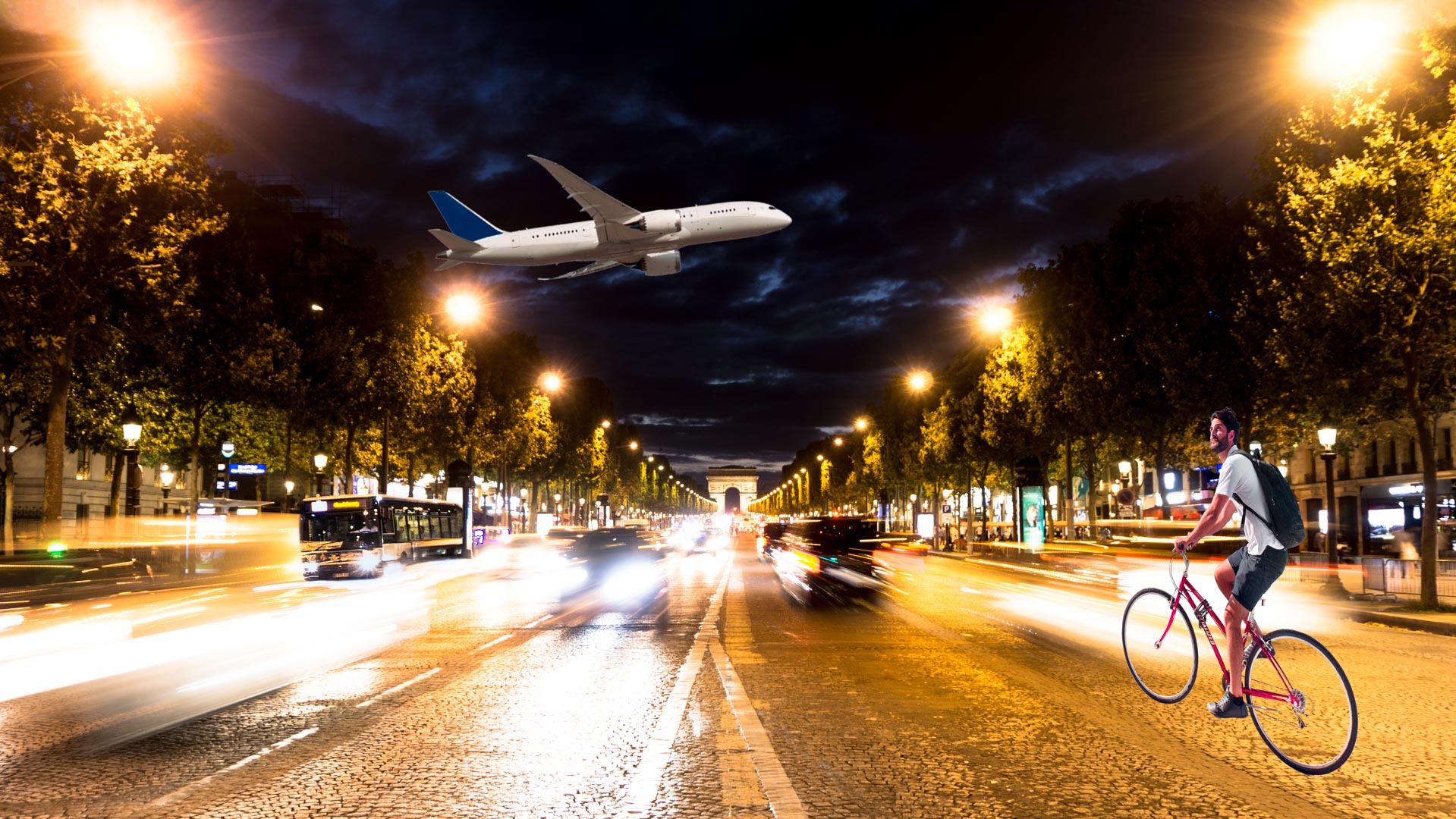While today we have no difficulty in estimating our carbon footprint thanks to the multitude of online calculators (particularly for transport, housing and services), it becomes much more difficult to find reliable figures for more alternative travel modes… Using the few resources available and the expertise of Clément, an energy engineer, we will try to detail, in this post, the calculation methods to estimate your carbon footprint while hitchhiking!
Note: only greenhouse gas emissions (the most common factor used in environmental analysis today) will be discussed here.
Hitchhiking: a zero carbon footprint?
We’d like to start by fighting a common misconception: any travel trip pollutes (more or less). Even by walking! Regarding hitchhiking trips, many believe that hitchhikers’ carbon footprint is null, because the hitchhiker takes an available seat inside a vehicle already in motion, which should not travel more kilometres than expected (unless the driver makes a small detour to drop off his passenger, but this remains a rare, anecdotal case). Except that… When hitchhiking, we also have to take into account the weight we add to the vehicle: us, our bags… Weights which are, compared to the total weight of a small car, not negligible… Yet, the heavier the vehicle is, the more it will consume fuel to move forward, and the more it will pollute.

More about energy, transports and ecology
Calculate your carbon footprint by land hitchhiking
Hitchhiking cars
To calculate our carbon footprint by hitchhiking cars and compare the results with other modes of transport, we take into account two parameters: the average greenhouse gas emission of a car, and its consumption according to the added weight.
- Greenhouse gas balance of a car: we relied on data available on ADEME website (French Agency for the Environment and Energy Management). In our calculations, we will use the average value of 193gr of CO2eq emissions/km per car (but in detail, it can go from simple to double between a small car and a big 4×4)
- The consumption of a vehicle according to added weight: for this point, two sources complemented each other.
First, Clément has demonstrated in his analysis of ecology and transport the following:
Let’s take the simple example of a classic car that consumes 10L/100km: the hitchhiker, who weighs an average 80kg with his bag, represents about 5% of the weight of the car (1500kg). If we consider the car consumption as being linear to its weight, (which is actually not quite true, but close), the car will consume an additional 5% of fuel or 10.5L/100km.
Then, according to the car specialist Caradisiac, the weight would impact fuel consumption as follows:
Fuel consumption of a passenger car increases by 7% when the vehicle has a 100 kg weigh added.
Even if it’s difficult to obtain precise values, these two approaches have allowed us to obtain more or less the same result: a hitchhiker, depending on his or her weight, and his/her bag weigh (between 65 and 100 kg in total), will contribute to increase the average fuel consumption of a car by 4 to 7% (from 7.7gr to 13.5gr CO2/km/passenger more).
Hitchhiking trucks
Calculating our carbon footprint when we hitchhike trucks becomes more complicated: we have to take into account the model of the truck, its tonnage, its real capacity when you hitchhike it (does it run empty? full?), etc.
Here are some numbers that we would like to share:
- a truck that can carry 40 Tons weighs approx. 8 Tons empty.
- a fully loaded 40-ton truck consumes an average of 39.2L/100 km, whereasan empty truck consumes about 29.3L/100 km – but be careful, these numbers would only be valid for a truck driving on highway. On other roads types, as you can well imagine, figures explode!
When you add 32 Tons to an empty truck, it means increasing its average consumption by 34%. By linear regression, we can deduce that adding 100kg increases the average truck consumption by about… 0.1%. The impact is very negligible, 100 times less than with hitchhiking a car for example. Once again, we would like to moderate this figure because many factors come into play… It’s a simply estimation, to give us an idea of the hitchhiking impact!
Comparison of hitchhiking with other modes of transport
Carpooling vs hitchhiking
Still using our example of a car that would emit 193gr CO2/km per passenger, and taking into account the increase in weight of the car (which online calculators don’t at the moment), we obtain the following results:
- A car with 2 passengers: its impact is about 100-104gr CO2/km per person
- A car with 4 passengers: its impact is about 54-58gr CO2/km per person
In comparison, and as we have seen previously, hitchhiking would mean increasing the vehicle’s consumption by 4 to 7%, so like between 7.7 and 13.5gr CO2 emitted/km per additional passenger. Furthermore, as Clement points out:
The driver, in a case of carpooling, will (not always, but quite often) define his/her route for economic reasons. It’s indeed more advantageous to carpool rather than buying a bus/train ticket, but driving alone is not advantageous in terms of ecology! So there is a financial argument that motivates carpooling market: it’s in the expectation and hope of having passengers that the driver will also travel by car. In this particular case, the pollution is shared equally among all the passengers.
Long-distance bus vs hitchhiking
According to ADEME data, the average CO2 emission in long-distance bus would be about 26gr CO2/km/passenger (2 times better than a car with 4 passengers). In comparison, we emit 2 to 5 times less of CO2/km by hitchhiking!
Plane vs hitchhiking
Although this comparison is tempting, it’s extremely difficult to compare these two modes of travel – because the distances travelled and the time spent travelling are completely different.
Intrigued, through our yearly overviews, we compared our carbon footprint for the year by hitchhiking a specific distance, versus an estimation of our carbon footprint if we had travelled the same distance by plane. And the results are indisputable!
Even if a journey by plane is always more direct than a journey by land (no geographical constraints), by focusing only on distances, we realize that a journey by plane is not at all ecological. For example, if you travel 17,000 km (equivalent to a one way Paris-Sydney by plane), you end up with a CO2 balance of 3,6 tons/person for the plane, versus… 131kg to 229,5kg CO2/person for the same distance traveled by hitchhiking only.
Note: our calculation is based only on CO2 emissions, but other elements should also be taken into account: fine particles emissions, ecological cost of manufacturing a car or an aircraft, pollution linked to human activity and all services on board (food, paper, plastics…). In any case, by adding these parameters, an aircraft is generally more polluting.
The carbon footprint in sailboat hitchhiking and charter
Same as truck hitchhiking, many factors come into play when calculating the carbon footprint of a sailboat we hitchhike: engine or sail usage, engine speed (rpm), engine model, boat size, tonnage, etc. In our adventure, we sailed with captains who turned on the engine every day to move faster as soon as the wind disappeared, as with a captain who only used his sails for a 14-day crossing at sea…
When we hitchhike a sailboat, we only consider the weight that our presence adds (our own weight, the weight of our bags, fresh water and food in addition…) to estimate the carbon footprint of the engine’s excess consumption – on the same principle as hitchhiking. Thanks to a calculator that a skipper and shipyard engineer friend has gave us, and taking the example of a 15-metre (49 feet) sailboat, we can estimate that at 10 tons the engine consumes 1.786L/h to speed the boat at 5 knots, in comparision with 1.792L/h consumed for 10.1 tons. We can say that, by adding 100kg would be equivalent to increasing engine consumption by 0.35% (if used). This is of course an order of magnitude, but it’s much more negligible than a hitchhiking trip!
If you’d like to go into detail about the numbers, we can share with you a precise example of a carbon footprint calculation with a sailboat – based on one of our experiments where we knew exactly how much fuel had been consumed!
- Number of people aboard: 4 (the captain, plus 3 crew members)
- 40L of diesel fuel consumed
- consumption estimated at 2L/h, with an engine running on average at 2000 rpm (regular speed)
- average speed with engine on: 5 knots (5 nautical miles per hour, or 9.26 km done in an hour)
- total distance covered: 500 km
- estimation of the distance traveled with the engine on: 185km
- average CO2 emission: 2,3 kg CO2/L
If this trip was considered as chartering, our carbon footprint would have been of 46gr CO2/km/person – or the same scale as a carpooling carbon footprint with 4 passengers aboard!
This example is also interesting, because our captain had a reasoned use of the engine for coastal navigation (manoeuvres in/out of the anchorage point, wind too weak to inflate the sails). However, when sailing on the open sea, the use of the engine may be much rarer.
Other hitchhiking cases: aircraft-hitchhiking, ferry-hitchhiking…
We end this apost by mentioning other forms of hitchhiking, more exceptional. As for car hitchhiking, the aim of the hitchhiker is to occupy an empty seat, in a aircraft/ship whose departure is already planned. The weight added by the hitchhiker is negligible compared to the total weight of the aircraft/ship. (between 41 et 80T for a Boeing 737-800, 19500T for our filipino ferry at full capacity), we can say that the impact of the added weight will be null on the total consumption.
On the other hand, there is another impact with these other forms of hitchhiking that noboady talk about much. Unless you manage to hitchhike a private jet, these highly polluting forms of transport, obey the market laws (supply according to the demand). When a hitchhiker manages to get on a plane or ferry for free, his or her name is on the passenger list – and is added to the company’s statistics. In addition, in exchange for the free ticket, the company often asked for a consideration such as advertising… As you can see, hitchhiker will create demand – which will indeed generate more pollution. Hitchhiking cars and sailboats are therefore preferable, the more possible!

More about Alternative Travel
* Post written according to our personal experience *